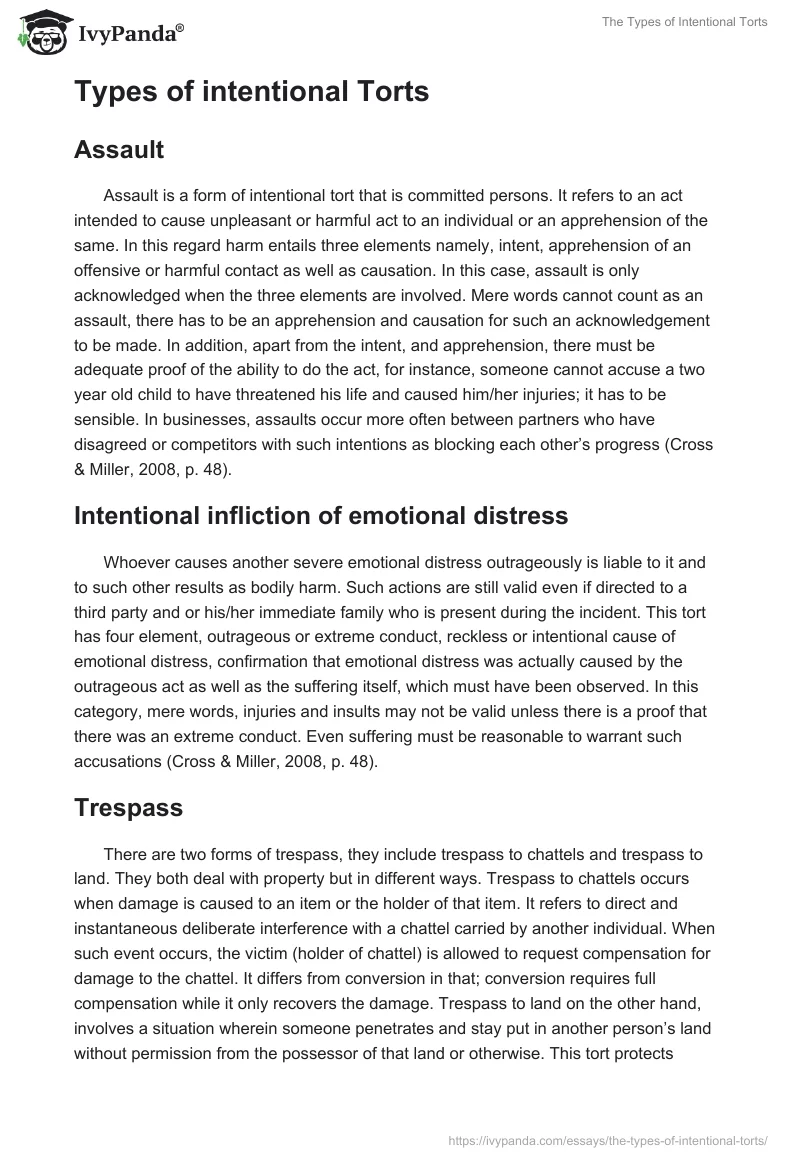Introduction
Law helps in ensuring continuity, stability as well as predictability in the way people conduct their affairs. Businesses cannot be conducted without law, for law essentially ensures its continuity. Every institution and organization has laws that are created to ensure there is smooth conduct of activities. In Jurisdictions such as common and civil law, the former includes wrongs such as torts while the latter includes its equivalent, known as delict. Tort refers to civil wrongs that entail a breach of civil obligation, resulting in injury to an individual or property. There are three main examples of torts namely intentional tort, negligence, strict liability, among others. This paper will explore tort as well as the types of intentional torts (Mojo Law, 2011, p. 1).
Intentional Torts.5
Tort is defined as a civil wrong doing which involves causing injury to an individual or his/her property. In such a case, the one who commits such wrongs is referred to as a tortfeasor. Tort deals with remedies and rights against injuries that may occur due to carelessness or those committed intentionally. It therefore covers injuries to individuals without real attention on who is to blame. There are three main types of torts namely intentional, liability, and negligence torts. In this paper we shall explore intentional tort (Mojo Law, 2011, p. 1).
Intentional tort refers to a deed or action that is designed or done purposefully to injure someone or his/her property. In most cases the tortfeasor usually have a pre-determined intention to cause harm without care. Such situations call for protection of the victim and may lead to compensations. In business world, such events are common between staffs, as well as other competitors. There are several types of intentional torts. These includes false imprisonment, fraud, misrepresentation, battery, trespass , malicious prosecution, computer defamation, title slander, abuse of process, infliction of distress (emotional) to an individual, assault and conversion, among others. This paper will explore in detail, three of the above types of intentional torts. These shall be assault, intentional infliction of emotional distress and trespass (Cross & Miller, 2008, p. 48).
Types of intentional Torts
Assault
Assault is a form of intentional tort that is committed persons. It refers to an act intended to cause unpleasant or harmful act to an individual or an apprehension of the same. In this regard harm entails three elements namely, intent, apprehension of an offensive or harmful contact as well as causation. In this case, assault is only acknowledged when the three elements are involved. Mere words cannot count as an assault, there has to be an apprehension and causation for such an acknowledgement to be made. In addition, apart from the intent, and apprehension, there must be adequate proof of the ability to do the act, for instance, someone cannot accuse a two year old child to have threatened his life and caused him/her injuries; it has to be sensible. In businesses, assaults occur more often between partners who have disagreed or competitors with such intentions as blocking each other’s progress (Cross & Miller, 2008, p. 48).
Intentional infliction of emotional distress
Whoever causes another severe emotional distress outrageously is liable to it and to such other results as bodily harm. Such actions are still valid even if directed to a third party and or his/her immediate family who is present during the incident. This tort has four element, outrageous or extreme conduct, reckless or intentional cause of emotional distress, confirmation that emotional distress was actually caused by the outrageous act as well as the suffering itself, which must have been observed. In this category, mere words, injuries and insults may not be valid unless there is a proof that there was an extreme conduct. Even suffering must be reasonable to warrant such accusations (Cross & Miller, 2008, p. 48).
Trespass
There are two forms of trespass, they include trespass to chattels and trespass to land. They both deal with property but in different ways. Trespass to chattels occurs when damage is caused to an item or the holder of that item. It refers to direct and instantaneous deliberate interference with a chattel carried by another individual. When such event occurs, the victim (holder of chattel) is allowed to request compensation for damage to the chattel. It differs from conversion in that; conversion requires full compensation while it only recovers the damage. Trespass to land on the other hand, involves a situation wherein someone penetrates and stay put in another person’s land without permission from the possessor of that land or otherwise. This tort protects exclusive rights of the possessor to determine whoever enters his/her possession. This right can be possessed by whoever is assigned to that land without necessarily owning it. For instance a caretaker has a legal right to exclude whoever he/she wishes from a plot, that is, if he is given that authority by the owner or otherwise. Several land disputes tend to cause trespass torts in businesses (Cross & Miller, 2008, p. 48).
Conclusion
Tort is civil wrong found in common law jurisdictions and is equivalent to delict in civil law. It entails the cause of injury to an individual or his/her property. It therefore tries to give remedy or rights to those injured due to negligence or with intent. Negligence, intentional and liability are the main forms of torts; Intentional tort is further divided into several types such as battery, assault, and slander, among others. The paper covered trespass, assault and, Intentional infliction of emotional distress, which are most common in business organizations (Mojo Law, 2011, p. 1).
Reference List
Cross, F. B., & Miller, R. L. (2008). The legal environment of business: Text and cases – ethical, regulatory, global, and e-commerce issues. (7th ed.). West: Cincinnati.
Mojo Law. (2011). Tort & Tort Law: Fundamental Concepts of Tort. MojoLaw.com. Web.


